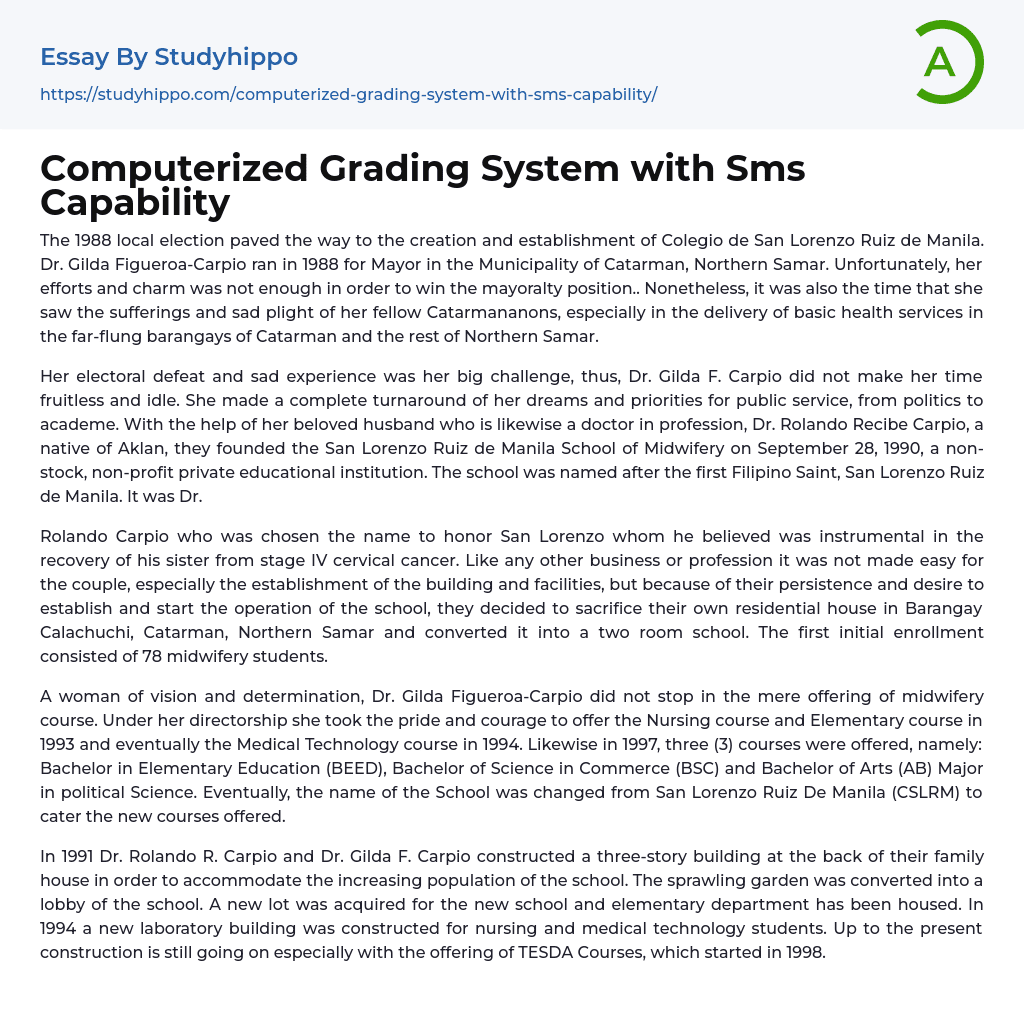

Computerized Grading System with Sms Capability Essay Example
In 1988, the local election led to the establishment of Colegio de San Lorenzo Ruiz de Manila. During the election, Dr. Gilda Figueroa-Carpio ran for Mayor in the Municipality of Catarman, Northern Samar. Despite her efforts and charm, she was unable to win the mayoralty position. However, it was during this time that she witnessed the suffering and difficult situation of her fellow Catarmananons, particularly in accessing basic health services in the remote barangays of Catarman and Northern Samar as a whole.
Despite facing electoral defeat and a disappointing experience, Dr. Gilda F. Carpio turned her setback into an opportunity for personal growth. She transitioned from a focus on politics to a dedication to academia, reshaping her dreams and priorities for public service. Together with her husband, Dr. Rolando Recibe Carpio, who is also a doctor, they established th
...e San Lorenzo Ruiz de Manila School of Midwifery on September 28, 1990. This non-stock, non-profit private educational institution was named after the first Filipino Saint, San Lorenzo Ruiz de Manila.
Rolando Carpio, who opted to name the school after San Lorenzo due to his belief in the saint's role in his sister's recovery from stage IV cervical cancer, faced the typical challenges of starting a business or profession. This included difficulties in establishing the building and facilities. However, driven by their determination and passion to open the school, they made the decision to convert their own residential house in Barangay Calachuchi, Catarman, Northern Samar into a two room school. The first batch of students consisted of 78 midwifery students.
Dr. Gilda Figueroa-Carpio, a woman with determination and vision, went beyond offering only a midwifery course
Under her leadership as director, she proudly and courageously introduced the Nursing, Elementary, and Medical Technology courses in 1993 and later added the Bachelor in Elementary Education (BEED), Bachelor of Science in Commerce (BSC), and Bachelor of Arts (AB) Major in political Science courses in 1997. This expansion of courses prompted a change in the school's name from San Lorenzo Ruiz De Manila (CSLRM) to accommodate the new offerings.
In 1991, Dr. Rolando R. Carpio and Dr. Gilda F. Carpio built a three-story building behind their family home to accommodate the growing school population. They transformed the expansive garden into a school lobby. Additionally, they acquired a new lot for the elementary department of the school. In 1994, a laboratory building was constructed for nursing and medical technology students. Construction is still ongoing, particularly with the introduction of TESDA Courses in 1998.
From 1990 to the present, the school has achieved significant accomplishments. However, for the school officials and staff, it is just the beginning in their pursuit of academic excellence. Their focus is on upgrading the faculty, research, and physical facilities. The increasing population of students from hundreds to thousands has highlighted the need for improvement in some outdated systems at CSLRM. These systems may not be equipped to handle the growing number of students. Therefore, upgrading this old system is crucial.
CSLRM could consider upgrading their grading system, as they currently use an annual grading system at the registrar's office. The registrar is responsible for holding the grades of students one week after the final exams. The grades submitted by instructors are compiled and kept by the registrar for student inquiries and
grade requests. However, there are issues with this manual system, as registrar personnel have to scan the compiled file to find a student's specific grade in a particular subject.
In order to receive another grade, the personnel must repeat the action (and it should be noted that regular students have 7 to 8 subjects). Consequently, tracking grades multiple times becomes exhausting and frustrating for registrar personnel. Additionally, it is a time-consuming process that requires students to be patient in waiting for their grades. The manual grading system clearly lacks efficiency. Moreover, consider the situation where 10 to 50 students are waiting in line to receive their grades; this could potentially consume an entire day.
- Hospital essays
- Physician essays
- Health Care Provider essays
- Universal Health Care essays
- Readmission essays
- John Locke essays
- 9/11 essays
- A Good Teacher essays
- A Healthy Diet essays
- A Modest Proposal essays
- A&P essays
- Academic Achievement essays
- Achievement essays
- Achieving goals essays
- Admission essays
- Advantages And Disadvantages Of Internet essays
- Alcoholic drinks essays
- Ammonia essays
- Analytical essays
- Ancient Olympic Games essays
- APA essays
- Arabian Peninsula essays
- Argument essays
- Argumentative essays
- Art essays
- Atlantic Ocean essays
- Auto-ethnography essays
- Autobiography essays
- Ballad essays
- Batman essays
- Binge Eating essays
- Black Power Movement essays
- Blogger essays
- Body Mass Index essays
- Book I Want a Wife essays
- Boycott essays
- Breastfeeding essays
- Bulimia Nervosa essays
- Business essays
- Business Process essays
- Canterbury essays
- Carbonate essays
- Catalina de Erauso essays
- Cause and Effect essays
- Cesar Chavez essays
- Character Analysis essays
- Chemical Compound essays
- Chemical Element essays
- Chemical Substance essays
- Cherokee essays



